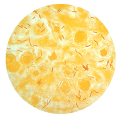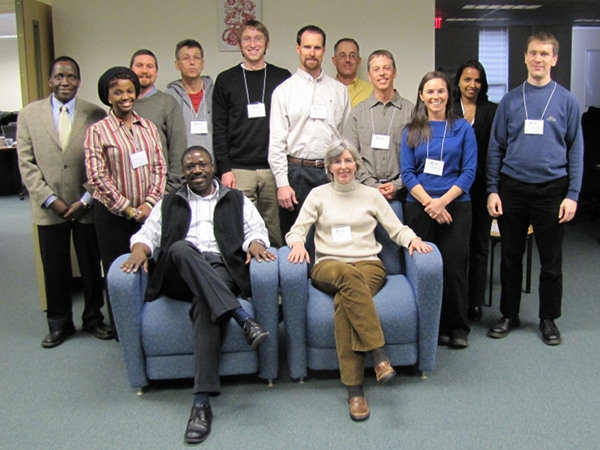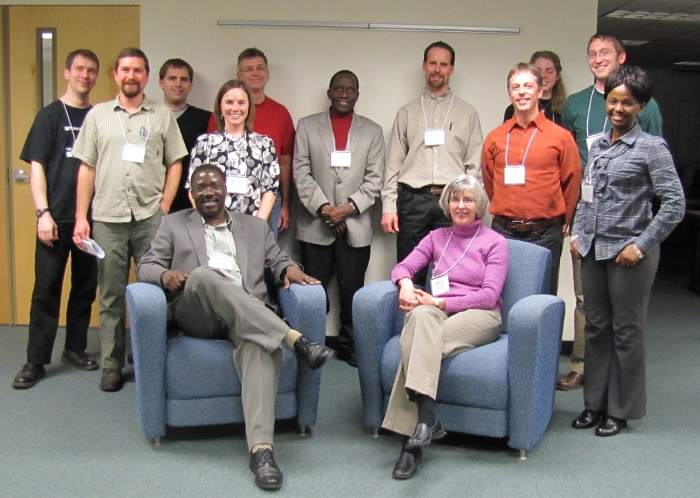| Description | Participants | Summaries | Products |
|---|

Archived NIMBioS Working Group
Modeling Bovine Tuberculosis
Topic: Modeling the impact of cattle movements on transmission dynamics of bovine tuberculosis (Mycobacterium bovis) in the United States at local and national scales
Organizers:
Colleen Webb (Colorado State Univ., Dept. of Biology and Dept. of Mathematics)
Agricola Odoi (Univ. of Tennessee, Dept. of Comparative Medicine)
Meeting dates: Feb 17-18, 2010; Jan 31-Feb 1, 2011; Dec 13-14, 2011
Project summary: Bovine Tuberculosis (TB) is an infectious chronic disease found primarily in cattle, but has been identified in many other species. Despite progress in the eradication of bovine TB in the United States, small pockets of infection still exist in cattle and wildlife, and the US spent approximately $31 million on eradication efforts in 2008 alone. The goal of this working group is to develop network models of cattle movement and the spread of bovine TB in the US that can be used to investigate alternative control and eradication strategies. Much of the progress in modeling bovine TB has been in European agricultural systems where cattle movement and disease spread data are highly detailed. The challenge to this working group is to develop similar models for the US, where cattle movements are more complex and only partially characterized. To meet this challenge, we have identified a number of cattle movement and TB datasets at both the state and national levels and assembled a group of experts in network and simulation modeling, bovine TB and control and eradication strategies. We propose to address questions regarding the sources and spread of bovine TB in areas with high local prevalence and at the national scale and how understanding the sources and spread of bovine TB can be used to inform control and eradication strategies. Additionally, we will address how uncertainty in both TB infection status and cattle movement impacts our inference. Four meetings of three days each are planned.

Meeting Summaries
| Mtg # | Dates | Agenda | Summary | Photo | Evaluation |
|---|---|---|---|---|---|
| 1 | Feb 17-18, 2010 | Link | Link | Report | |
| 2 | Jan 31-Feb 1, 2011 | Link | Link | Report | |
| 3 | Dec 13-14, 2011 | Link |
Meeting 1 Summary. During the first meeting of the TB Working Group, several key priority objectives and tasks were identified and sub-groups formed to work on these tasks. A number of US cattle movement and TB datasets at both the state and national levels are currently being assembled for use in subsequent network modeling to help understand cattle movements/interactions at both national and local scales and how this might impact transmission dynamics. Additionally, data from the UK, Sweden and Michigan will be used to assess the impact, on inference, of uncertainty in both TB infection status and cattle movement. At the next meeting of the Working Group, tentatively scheduled for October 2010, progress reports of each sub-group will be presented and discussed and new strategies for progress laid.
Meeting 2 Summary. The purpose of the second meeting was to (a) review working group progress since the 1st meeting; (b) review datasets collected so far and identify additional datasets that will be useful for the work; (c) review and identify the most appropriate modeling approaches to be used; and (e) prioritize key tasks and identify short and long-term goals/products going forward. Significant progress has been made in the collection, cleaning and descriptive analyses of the main datasets for the national model. The group continues to work on acquisition of data to parameterize a local (Michigan) model. The working group concluded by setting up three small groups each with unique tasks as well as short- and long-term plans and expected products.
Meeting 3 Summary. The purpose of the third working group meeting was to (a) review working group progress on our three objectives since the second meeting; (b) gain critical feedback on modeling approaches and directions; (c) discuss elements to be included in new bTB models; (d) discuss translatable outcomes for USDA; and (e) prioritize key tasks and identify short and long-term goals/products going forward. Significant progress has been made in the data collection and preliminary analysis of the national scale and Michigan data. Techniques for filling-in, scaling-up and characterizing uncertainty in the national scale data have been developed and look promising. These approaches can also be applied to state level data like Michigan. Preliminary disease simulations at the national scale have been developed for an easily transmitted disease as a way to explore linking movement to disease outcomes and policy questions while incorporating uncertainty. Details of how to expand this work to incorporate more technically difficult diseases like bTB were made. The working group concluded by relating current and planned work to USDA policy needs.
 |
| Meeting 1 participants (from left) John Kaneene, Folashade Agusto, Matt Farnsworth, Uno Wennergren, Michael Buhnerkempe, Jason Lombard, Graham Hickling, Ryan Miller, Katie Portacci, Shweta Bansal, Matthew Vernon; (seated) Agricola Odoi and Colleen Webb |
 |
| Meeting 2 participants (Back row, from left) Matthew Vernon, Mike Tildesley, Uno Wennegren, John Kaneene, Jason Lombard, Carolyn Gates, Michael Buhnerkempe. (Front row, from left) Matt Farnsworth, Katie Portacci, Ryan Miller, Fola Agusto. (Seated) Agricola Odoi and Colleen Webb |
NIMBioS Working Groups are chosen to focus on major scientific questions at the interface between biology and mathematics. NIMBioS is particularly interested in questions that integrate diverse fields, require synthesis at multiple scales, and/or make use of or require development of new mathematical/computational approaches. NIMBioS Working Groups are relatively small (up to 10 participants), focus on a well-defined topic, and have well-defined goals and metrics of success. Working Groups will meet up to 3 times over a two-year period, with each meeting lasting up to 2.5 days.
A goal of NIMBioS is to enhance the cadre of researchers capable of interdisciplinary efforts across mathematics and biology. As part of this goal, NIMBioS is committed to promoting diversity in all its activities. Diversity is considered in all its aspects, social and scientific, including gender, ethnicity, scientific field, career stage, geography and type of home institution. Questions regarding diversity issues should be directed to diversity@nimbios.org. You can read more about our Diversity Plan on our NIMBioS Policies web page. The NIMBioS building is fully handicapped accessible.
NIMBioS
1122 Volunteer Blvd., Suite 106
University of Tennessee
Knoxville,
TN 37996-3410
PH: (865) 974-9334
FAX: (865) 974-9461
Contact NIMBioS


